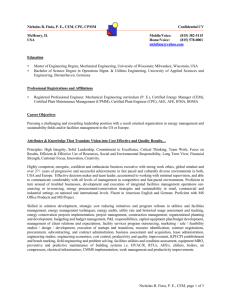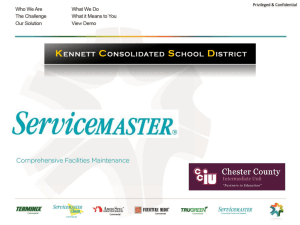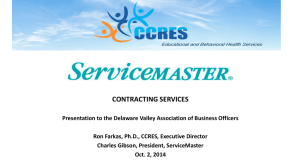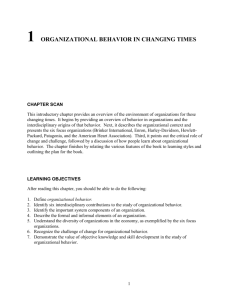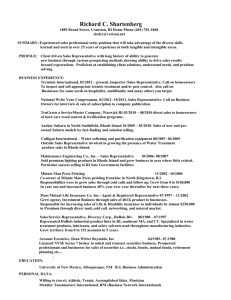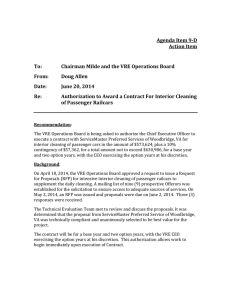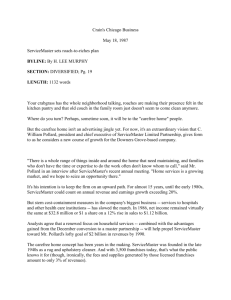15.660 Strategic Human Resource Management MIT Sloan School of Management
advertisement
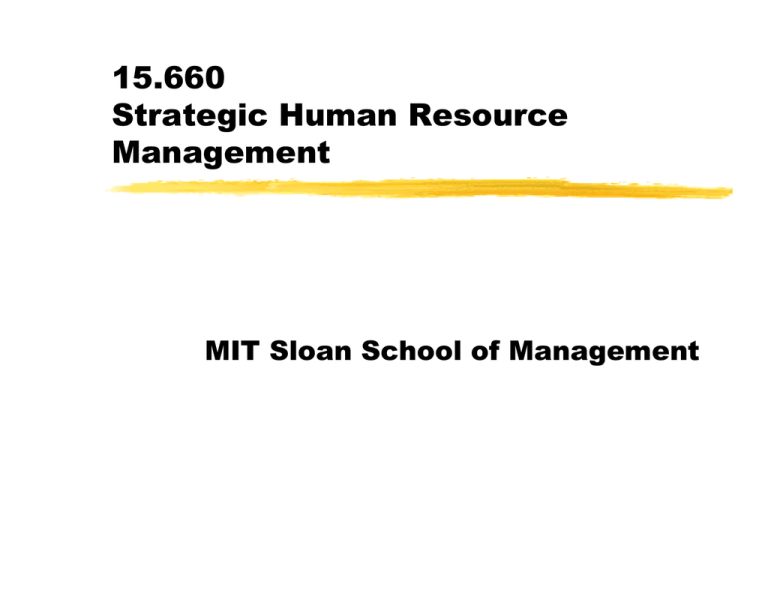
15.660 Strategic Human Resource Management MIT Sloan School of Management ServiceMaster Industries ? ? ? ? How have ServiceMaster’s values and goals contributed to their success? Why haven’t other firms successfully copied this approach? How important is training and development in the ServiceMaster system? How does training and development affect their continued growth? Why has ServiceMaster been willing to spend the resources it has on training and development for a set of low-skilled, high-turnover positions? ServiceMaster Industries ? ? ? ? ? ? Serve over 10 million customers in 41 countries with revenues of $6.4 billion 50,000 employees who manage a workforce of over 240,000 contract employees. Named most admired outsourcing company in America by Fortune in 1999 and 2000. Over 50% of employees are women and minorities. 29th consecutive year of growth in revenues and profit with a compounded growth rate of over 24% over the last 20 years. From 1987-1998 average of 68.5% return on shareholders’ equity. ServiceMaster Industries (1-800 WE SERVE) • Residential and Commercial Cleaning Services • Terminix (Pest control - 1986) • Merry Maids (Residential maid service - 1988) • American Home Shield (Home warranty service - 1989) • TruGreen (Lawn and tree service - 1990) • Since 1991: • ChemLawn • Rescue Rooter • Furniture Medic Diversified Health Services AmeriSpec American Residential Services ServiceMaster Revenues ($M) 6000 5000 4000 3000 2000 1000 0 1979 1983 1986 1988 1990 Note: excludes income from franchisees and international partners 1992 1994 1996 1998 ServiceMaster Industries Peter Drucker addressing ServiceMaster’s Board of Directors about their strategic intent: “Gentlemen, “Gentlemen, you you do do not not underunderstand stand your your business. business. Your Your business business isis to to train train the the least least skilled skilled people people and and make make them them functional.” functional.” ServiceMaster Industries “When people come in for an interview and see quotations from the Bible and our objectives on the wall, and when they talk to us and see how we try to implement our corporate objectives in a day-to-day manner, they either warm up to the way we do things or they are immediately turned off.” Lifetime Employee What What do do you you think think of of this this approach? approach? ServiceMaster Industries Basic Goals 1. To honor God in all we do. 2. To help people develop. 3. To pursue excellence. 4. To grow profitably. ServiceMaster Values and Creed “Providing opportunity for people to become all they were created to be.” ServiceMaster Annual Report “We want to help people be something before we ask them to do something.” “We don’t fire people for lack of skill. We fire people for attitude problems.” Kenneth Wessner Former Chairman ServiceMaster Industries “Frankly, when you view the person as only a production unit, or something than can be defined solely in economic terms, motivational or even incentive schemes have a tendency to be mechanistic and manipulative. In so doing, there is a drive to define a system that will idiot-proof the process, and one can in turn make people feel like idiots.” C. William Pollard Chairman, ServiceMaster ServiceMaster Industries “Frankly, when you view the person as only a production unit, or something that can be defined solely in economic terms, motivational or even incentive schemes have a tendency to be mechanistic and manipulative. In so doing, there is a drive to define a system that will idiot-proof the process, and one can in turn make people feel like idiots.” C. William Pollard Chairman, ServiceMaster What What isis your your reaction reaction to to this? this? ServiceMaster Industries Survey of Employees (1990) Since ServiceMaster has taken over this facility, how would you compare the following: Satisfaction Training Cleanliness Higher 52% 59% 48% No Change 33% 41% 33% Lower 15% 0% 19% ServiceMaster Industries The Wall Washing System Device Example: Benefits: Results: Training Wall Washing Wand Why? Patients respond faster in clean room. Reduce time required. Allows washing from erect position Worker understands why the wall needs to be clean and cares about the result. Improved efficiency. Less strain leads to higher satisfaction and lower turnover Quality improves. Worker is involved in big picture and is more committed. ServiceMaster: HR Practices Can this approach work elsewhere? • Other countries? What types? • Other industries? What characteristics? Why Would a Firm Pay to Train? Because its managers are stupid? According to neoclassical economics, the worker must pay for general on-the-job, either literally or through foregone earnings. Firm and employees must split the costs (and benefits) of firm-specific human capital in order to continue their mutually beneficial relationship and prevent “hold up” problems. Are there other reasons to pay for training? ? ? ? ? No choice (labor scarcity or deficient educational system) Specific human capital presumes general skills To give itself an incentive to use workers productively and efficiently Gift exchange and symbolism ? ? ? Employees reciprocate gift with loyalty and effort Focuses employee attention on strategic and developmental objectives “Training” presupposes “Caring” Why Pay to Train? “Optimal” investment in training can be a competitive game If your competitors are underinvesting in general training, you will be more reluctant to provide extensive training for fear of their “cream skimming” your workforce, unless you can otherwise bind the employees to the organization. Preserving Training Investments ? ? ? Bonding Training institutes Other HR practices • • • • • Screening (based on “trainability” and “stability”) Career pathing Broad job design; empowerment Pay for knowledge and/or seniority Benefits To safeguard investment (e.g., health care) To promote loyalty (e.g., dependent care) • Dress it up as “gift” • Train people in groups Jobs are Increasing in their Complexity How would you characterize the change in skill requirements in your establishment? NO CHANGE LESS COMPLEX MORE COMPLEX SAME/DIFFERENT SKILL 38% 3% 40% 18% source: Osterman, 1992 CHARACTERISTICS OF NATIONAL TRAINING SYSTEMS Amount of Training ? Opportunity for Mind Changing ? Mobility Level in the Labor Market ? Equality With Respect to Sex/Race/Immigrant Status ? Location of Training: School or Firm ? CHARACTERISTICS OF U.S. SYSTEM ? ENTRY DIVERSE AND DIFFUSE, NUMEROUS PATHS WEAK HIGH SCHOOL TRAINING COMMUNITIY COLLEGES STRONG ? FURTHER FIRM BASED PRIVATE TRAINING INFRASTRUCTURE STATE PROGRAMS WORK WITH FIRMS ? REMEDIAL SMALL AND INCOME STRATIFIED U.S. TRAINING PATTERNS, 1995 AVERAGE HOURS OF TRAINING PER EMPLOYEE IN SIX MONTH PERIOD FORMAL 10.7 INFORMAL 31.1 AVERGE PER EMPLOYEE TRAINING COSTS WAGES OF IN-HOUSE TRAINERS PAYMENTS TO OUTSIDE TRAINERS TUITION REIMBURSEMENT $139 98 51 TYPES OF TRAINING Remedial Upgrade “Hard” “Soft” Displacement/Transition TRAINING DECISIONS FOR FIRMS Level of Training/Resources Occupational Distribution Type of Training Make/Buy THE MAKE/BUY DECISION ? ? ? ? How Specific/General Is the Skill? How Important Is Socialization/Culture? How Important Is It That Supply Be Certain? What Is The Quality of External Providers? Takeaways ? ? ? ? Don’t underestimate non-monetary rewards. These can be especially powerful when they are congruent with employee values. Being clear about the organization’s values can help attract (and reject) people who “fit.” Training and development efforts need to be aligned and support job-relevant as well as value-relevant attitudes and behaviors. Training is an important means of signaling what’s important and valued in the organization.
